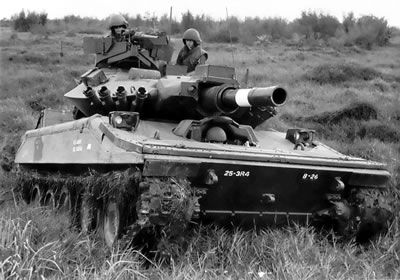
Last updated on February 19th, 2019 at 08:50 pm
The M551 Sheridan light tank was designed to replace the M41 light tank and the M56 self-propelled anti-tank gun, thus fulfilling both reconnaissance and anti-tank roles. The M551 was supposed to be an amphibious tank, like the Soviet PT-76 light tank, which had entered service in the 1950s. The Sheridan was also supposed to be air-deployable.
In 1960, the Allison division of General Motors received a contract to design a new Armored Reconnaissance Airborne Assault Vehicle (ARAAV).
The first prototype was finished in 1962. Eleven more prototypes followed.

Allison was awarded a contract to produce this vehicle, now known as the M551 Sheridan, in 1965. The first Sheridans were built in 1966.
When production began, there were many problems with the tanks, including problems with the automotive system, the missile system and the caseless ammunition rounds.
The problems weren’t fixed for another four years.
However, M551s were sent to Vietnam in 1968. Combat conditions during the Vietnam War exacerbated the tanks’ deficiencies.
Once the problems were fixed, M551s were issued to United States Army units in the United States, Korea and Germany.
The M551 weighs 15.6 tons (15,830 kg). It has an all-aluminum hull and a welded steel turret.
The Sheridan has a torsion-bar type suspension. There are five road wheels. The idler is at the front and the drive sprocket is at the rear. The tank does not have track return rollers.
Armament consists of a 5.98inch (152mm) main gun/missile launcher, a 0.3 inch (7.62mm) coaxial machine gun, and a 0.5inch (12.7mm) anti-aircraft machinegun.
There are four smoke dischargers on either side of turret.
The main gun/missile launcher can fire conventional ammunition, including HEAT rounds, or a Shillelagh missile.
A four-man crew operates the M551. The driver sits in the front of the hull. The gunner and the commander sit in the right side of the turret and the loader sits in the left side of the turret.
The Sheridan M551 has relatively thin armor, as it was designed to be light, amphibious and air deployable. The armor’s thinness made the M551 vulnerable to grenades and landmines in Vietnam. The tank could even be damaged by heavy machine gun fire.
The Sheridan’s small size and light armor also meant that it had difficulty making its way through the dense Vietnamese jungle.
Recoil was also a problem, as the main gun was too big for the chassis. When the gun was fired, the whole tank recoiled.
A floatation screen was used to make the Sheridan amphibious.
A variant of the M551, the M551A1, was developed in 1971. It has a thermal sighting system and improved suspension.
The M551 Sheridan began to be phased out of US service in 1978. However, the 82nd Airborne Division continued to use them until 1996.
M551 Sheridans were deployed during the United States’ invasion of Panama in 1989/1990 and during the 1990/1991 Gulf War.
M551 Sheridan Light |
|
|---|---|
| Active: | 1968 |
| Crew: | 4 |
| Weight: | 15.6 tons (15,830kg) |
| Length: | 20ft 8in (6.3m) |
| Height: | 9ft 8in (3.0m) |
| Width: | 9ft 3in (2.8m) |
| Weapons: | Main – 5.98in (152mm) gun/missile launcher, Secondary – 1 x 0.3in (7.62mm) coaxial machinegun, 1 x 0.5in (7.62mm) AA gun |
| Armor | n/a |
| Engine: | Detroit 6-cylinder 6V-53T diesel, 300hp |
| Speed: | 43mph (70kph) |
| Range: | 310 miles (600 km) |
